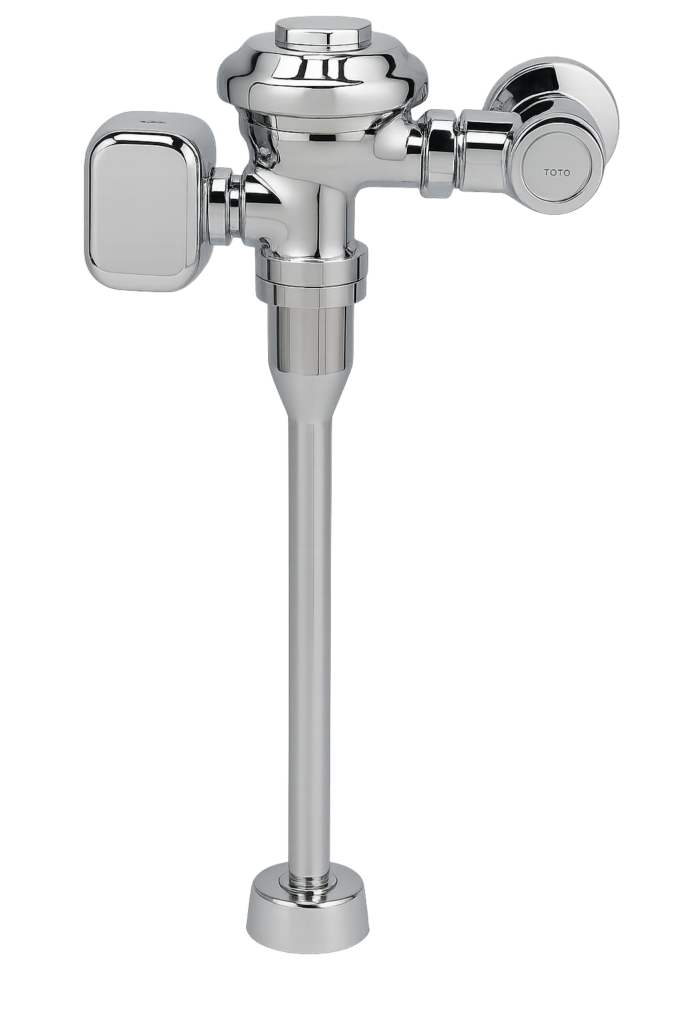
Touchless flush valves, also known as automatic flush toilets, use infrared sensor technology to detect when a user has finished using the toilet. They automatically initiate a flush without the need for physical contact, improving hygiene and reducing the spread of germs. But how do they really work? And what happens when the power source fails?
Let’s explore how these devices function and the differences between their use in public restrooms vs. homes.

Find touchless flush valve
🔍 How Touchless Flush Valves Work
1. Sensor Assembly
At the heart of the system is an infrared (IR) sensor. This sensor sends out invisible infrared beams that bounce off the user. When the user moves away or waves a hand, the reflection pattern changes, triggering the flush.
2. Solenoid Valve
Once the signal is sent, a control module activates a solenoid valve—an electrically powered valve that opens to allow water into the toilet bowl.
3. Flush Activation
The typical process is:
- User approaches → sensor detects presence → enters “standby” mode.
- User walks away or waves → sensor triggers flush.
- Solenoid valve opens → water flows → flush occurs.
- Valve closes automatically.
4. Water-Saving Features
Some advanced models include dual-flush capabilities:
- A quick wave = half flush.
- A longer wave or full departure = full flush.
This helps conserve water based on usage.

Find touchless flush valve
🔋 Do Automatic Flush Toilets Use Batteries or Electricity?
✅ Battery-Powered Models
- Use AA or 9V batteries.
- Common in residential and low-traffic commercial use.
- Lasts 1–2 years depending on usage frequency.
✅ Hardwired (Electric) Models
- Directly connected to the building’s electrical system.
- Common in high-traffic commercial restrooms.
✅ Hybrid Models
- Use electricity with battery backup.
- Ensures uninterrupted function during power outages.
⚠️ What Happens If There’s No Power or Dead Batteries?
When the power source fails:
| Power Type | Result When Power Fails |
|---|---|
| Battery | No automatic flush until battery is replaced |
| Electricity (AC) | Flush fails if no backup battery present |
| Hybrid (AC + DC) | Backup battery allows continued operation |
In most cases, you will still be able to flush manually using a built-in override button.
🧼 Can I Flush It Manually?
Yes! Most touchless flush toilets have a manual override mechanism, such as:
- A small chrome or plastic button near the sensor.
- A screw-type knob on the side of the valve.
- Labeled “Manual” or shown as a small protrusion.
If your unit lacks this, consult the manufacturer’s manual or product page.

Find touchless flush valve
🪣 Can I Flush It with a Bucket of Water?
Yes — in emergencies, you can flush manually with a bucket of water, bypassing the sensor system.
🏢 Public Restrooms vs. 🏠 Homes: Challenges & Considerations
👎 Common Problems in Public Toilets
| Problem | Description |
|---|---|
| 🔋 Frequent battery drain | Due to high usage, batteries need frequent replacement. |
| 💧 Phantom flushes | Over-sensitive sensors trigger unwanted flushes, wasting water. |
| 🚫 Under-flushing | Sensors sometimes fail to detect users, leaving waste unflushed. |
| 🛠️ Maintenance complexity | Sensors, wiring, and solenoids require expert maintenance. |
| 😡 User frustration | Confusion when flush doesn’t trigger as expected. |
| 🔨 Vandalism risk | Units may be tampered with, sensors covered, or components damaged. |
| 🔊 Loud noise | High-pressure commercial flushes can be noisy and jarring. |
🏠 Issues in Home Use
| Problem | Description |
|---|---|
| 💰 Higher cost | Units and installation are more expensive than manual flush toilets. |
| 🔋 Battery replacement | Less frequent than public restrooms, but still needed. |
| 🛠️ Harder repairs | Requires skilled technicians for electronic issues. |
| 🚿 Water line compatibility | Some touchless toilets need larger pipes not found in most homes. |
| 🤷 Perceived unnecessity | Some homeowners don’t see the value over manual options. |
✅ Final Summary
| Feature or Question | Answer |
|---|---|
| How do touchless flush valves work? | Sensor → control module → solenoid valve → automatic flush. |
| Are they battery or electric powered? | Both. Some models use both for backup. |
| What if there’s no power or battery? | No auto flush; manual button may still work. |
| Can I flush it manually? | Yes, most have a built-in manual flush button. |
| Can I flush it with a bucket of water? | Yes, in emergencies. Works well for home toilets. |
| Are they better for public or home use? | Public restrooms benefit more from hygiene and automation. |

Find touchless flush valve
📝 Conclusion
Touchless flush toilets are a modern solution to hygiene and convenience. They are particularly effective in public restrooms but come with higher maintenance demands. At home, they offer a luxury feel and can be useful for hands-free operation — provided you’re aware of the occasional quirks.
When used properly and maintained regularly, these smart toilets make for a cleaner, more efficient restroom experience.
🔗 Affiliate Disclosure: Some links in this post may be affiliate links. This means if you click on them and purchase, we may earn a small commission at no extra cost to you. This helps support our content creation efforts.
🧑💻 About the Author:
Sujith Shanmugam is a content creator and reviewer of home automation tools and smart living gadgets. With a background in digital media and engineering, he simplifies tech concepts for practical everyday use.